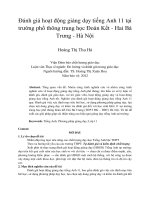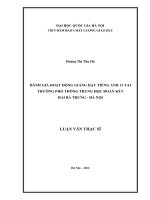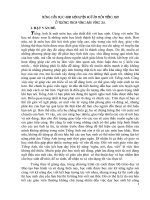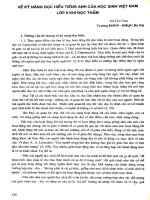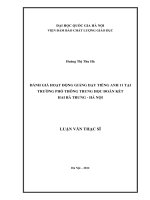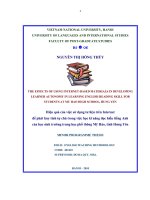Bài tập luyện đọc hiểu tiếng anh cho học sinh phổ thông trung học
Bạn đang xem bản rút gọn của tài liệu. Xem và tải ngay bản đầy đủ của tài liệu tại đây (2.63 MB, 217 trang )
D1r
/ ĩl ĩ Lì ÌJJ
họệsinh
PTTH
ĨS%.ằNHÀ XUẤT BẢN HỐNG BÀNG
BÀI TẬP LUYỆN ĐỌC
H líu TIÊNG ANH
CHO HỌC SINH THPT
THANH BÌNH
^àJ/tệưp
Luyện
Đọc Hiểu
họcsinh PTTH
NHA XUẤT BÀN HỐNG BẲNG
LỜI NÓI ĐẤU
Khi học tiếng Anh, việc học kỹ năng nghe, nói và viết là
rất cẩn thiết, nhưng kỹ năng đọc cũng không kém phần quan
trọng. Bạn có bao giờ cảm thấy việc đọc hiểu một đoạn văn
hay một bài báo bằng tiếng Anh mất quá nhiều thời gian với
bạn? Đôi khi, bạn có thể đọc với tốc độ từ 200 đến 350 từ
trong một phút nhưng bạn lại không nắm được nội dung của
toàn bài hay bỏ qua một vài ý chính? Điều này hoàn toàn có
thể xảy ra nếu bạn không biết cách đọc hiểu nhanh và hiệu
quả.
Nhằm cung cấp cho người học tiếng Anh một tài liệu
tham khảo phù hợp để luyện tập kỹ năng đọc hiểu tiếng Anh,
đặc biệt là cách xử lý các dạng bài tập kiểm tra kĩ năng đọc
hiểu khác nhau, thường gặp trong các đề thi tốt nghiệp THPT
và tuyển sinh ĐH-CĐ, chúng tôi xin trân trọng giới thiệu tới
bạn đọc cuốn sách "Bài tập luyện đọc hiểu tiếng Anh cho
học sinh THPT
Nội dung sách bao gổm bốn phần chính như sau:
Phần 1: Câu hỏi đọc hiểu (Comprehension Questions)
Phần này gồm các bài tập yêu cầu người học chọn lựa đáp án
đúng nhất theo dạng trắc nghiệm. Thông tin giúp người học
tìm câu trả lời đúng có thể dựa vào từ (cụm từ) hoặc thông
qua ý của câu và đoạn văn.
5
Phần 2: Trắc nghiệm từ vựng (Multiple Choice
Vocabulary) Phần này gồm những bài đọc ngấn với 10 ô
trống. Dựa vào 10 nhóm từ đã cho, người học chọn từ đúng
để hoàn thành đoạn văn.
Phần 3: Câu đúng - sai (True - False) Phần này yêu cẩu
người học xác định nội dung các câu đúng hay sai so với nội
dung đoạn văn
Phẩn 4: Hoàn chỉnh đoạn văn (Text Completion) Phấn
này gổm hai dạng bài: Gap - filling: đây là dạng bài chọn từ
đúng trong số các từ cho sẵn để điển vào các chỗ trống trong
đoạn văn; Cloze: dạng bài tập này yêu cẩu hoàn chỉnh đoạn
văn bằng cách điền từ còn thiếu vào các khoảng trống trong
đoạn văn - một từ cho mỗi khoảng trống.
Chúng tôi mong rằng, cuốn sách "Bài tập luyện đọc
hiểu tiếng Anh cho học sinh THPT" sẽ giúp các em học sinh
nâng cao được kỹ năng đọc hiểu và làm tốt phần bài tập đọc
hiểu trong chương trinh học tiếng Anh ở bậc THPT cũng như
trong các để thi tốt nghiệp THPT và tuyển sinh ĐH - CĐ.
Trong quá trình biên soạn, chắc chắn không thể tránh
khỏi những sai sót, nhẩm lẫn, vì vậy rất mong nhận được
những ý kiến đóng góp quý báu của bạn đọc để cuốn sách
được hoàn thiện hơn trong lẩn tái bản sau.
Xin chân thành cảm ơn.
6
PHẦN I: Cfitl MỎI ĐỌC HIỂU
¿ S o m p ^ e k e s io K v Q u e s í i c m s
TEST1
Communication in general is process of sending and
receiving messages that enables humans to share
knowledge, attitudes, and skills. Although we usually
identify communication with speech, communication is
composed of two dimensions -verbal and nonverbal.
Nonverbal communication has been defined as
communication without words. It includes apparent
behaviors such as facial expressions, eyes, touching, tone
of voice, as well as less obvious messages such as dress,
posture and spatial distance between two or more people.
Activity or inactivity, words or silence all have
message value: they influence others and these others, in
turn, respond to these communications and thus they are
communicating.
Commonly, nonverbal communication is learned
shortly after birth and practiced and refined throughout a
person’s lifetime. Children first learn nonverbal
expressions by watching and imitating, much as they
learn verbal skills.
Young children know far more than they can
verbalize and are generally more adept at reading
nonverbal cues than adults are because of their limited
verbal skills and their recent reliance on the nonverbal to
communicate. As children develop verbal skills,
nonverbal channels of communication do not cease to
8
exist although become
communication process.
entwined
in
the
total
1. According to the writer,________
A. Nonverbal language is only used by the deaf and
the mute.
B. One cannot communicate in both verbal and
nonverbal language.
C. Those who can listen and talk should not use
nonverbal language.
D.
People communicate with
nonverbal language.
both verbal
and
2. Which is not included in nonverbal communication?
A. words.
B. spatial distance.
C. facial expressions.
D. tone of voice.
3. We can learn from the text that________
A. nonverbal can never get any responses.
B. most people do not like nonverbal communication.
C. even silence has message value.
D. touching is not accepted in communicating.
4. Human beings________
A. have learnt how to communicate in nonverbal
language through books.
B. can communicate in nonverbal language only when
they are mature.
9
C. have learnt how to communicate in nonverbal
language since a child.
D. communicate in nonverbal language much less
than they do in verbal language.
5. The word "reading" has a close meaning to ________
A. looking at the words that are written.
B. understanding.
C. saying something aloud.
D. expressing.
TEST 2
A public house which was recently bought by Mr.
Ian Thompson is up for sale. Mr. Thompson is going to
sell it because it is hunted. He told me that he could not
go to sleep one night because he heard a strange noise
coming from the bar. The next morning, he found that
the doors had been blocked by chairs and the furniture
had been moved. Though Mr. Thompson had turned the
light off before he went to bed, they were on in the
morning. He also said that he had found five empty
whisky bottles which the ghost must have drunk the
night before. When I suggested that some villagers must
have come in for a free drink, Mr. Thompson shook his
10
head. The villagers have told him that they will not accept
the inn even if he gives it away.
1. Mr. Thompson wants to sell his inn because_______
A. he heard a strange noise from the bar.
B. he found the doors had been blocked by chairs.
C. he found five empty whisky bottles.
D. he thinks it’s visited by a ghost.
2. Mr. Thompson_______
A. believes in ghost.
B. thinks the villagers are playing a trick.
C. wants to give it away .
D. thinks the villagers drank the whisky.
3. Mr. Thompson is selling his inn. This means his inn is
A sold.
B. to let
.
C. for selling.
D. for sale.
4. The word "they" in line 5 refers to which of the
following?
A. the ghosts.
B. the lights.
C. the bottles.
11
D. the doors.
5. Which of the following is NOT mentioned in this
passage?
A. Mr. Thompson doesn’t want to live in that bar.
B. There was something unusual happened in his inn.
C. Mr. Thompson saw five ghosts drinking whisky.
D. The writer thought that some people entered his
house and drank whisky.
TEST 3
Sometimes you know things about people the first
time you see them, for example, that you want to be
friends with them or that you don’t trust them. But
perhaps this kind of intuition isn’t as hard to explain as it
may seem. For instance, people give out body language
signal all the time. The way you hold your body, head
and arms tells people about your mood. If you hold your
arms tightly at your sides, or fold them across your chest,
people will generally feel that you are being defensive.
Holding your head to one side shows interest in the
others, while an easy, open posture indicates that you are
self-confident. All this affects the way you feel about
someone.
12
Also, a stranger may remind you of a meeting with
someone. This may be because of something as simple as
the fact that he or she is physically similar to someone
who treated you well or badly. Your feeling about a
stranger could be influenced by a smell in the air that
brings to mind a place where you were happy as a child.
Since even a single word can bring back a memory such
as that, you may never realize it is happening.
1. What does the word “open” in the passage most closely
mean?
A unrestrained.
B. relaxed.
C. confined.
D. unlimited.
2. What influences your impression of a person you meet
the first time?
A intuition.
B. familiarity.
C. knowledge.
D. feeling.
3. What one fells about a stranger may be influenced by
something that_______
A. strengthens one’s past behaviors.
B. reminds one of one’s past treatment.
C. revives one’s past memories.
D. points to one’s childhoods.
4. What does the second paragraph discuss?
A. Meanings of signal some implies towards a
stranger.
13
B. Factors that may influence one’s feelings about a
stranger.
C. How people usually behave to a stranger.
D. Factors that cause people to act differently.
5. Intuition described in the passage can be explained by
means of_______
A. styles.
B. languages.
C. patterns.
TEST 4
Upon the creation of the United State, one of the
core concepts on which the hopes for the new democracy
were pinned was the ideal that its citizens would be
enlightened individuals with clearly articulated rights and
the opportunity for individual achievement and
education. It was believed that in a free nation where the
power belongs to the people, the commitment to
education defines the progress of that democracy and is
the catalyst for future progress. This core value has not
only stood the test of time but has also grown in
importance. In this new Information Era and international
economy, education is an increasingly vital commodity, a
precursor of potential success and a driving force of
chance. It is importance to recognize, however, that we
approach education today differently than in the past,
partly because the kinds of jobs people had didn’t require
14
the kind of basic education and specialized training that
is often required in the workforce today. In the 1950s, for
instance, only 20 percent of American jobs were classified
as professional, 20 percent as skilled; and 60 percent as
unskilled. Today, our world has changed. The proportion
of unskilled jobs has fallen to 20 percent, while jobs now
account for at least 60 percent of the workforce. Even
more important, almost every job today increasingly
requires a combination of academic knowledge and
practical skills that require learning throughout a
lifetime.
1. Education is defined in this passage as a driving force
of chance because________
A.
without education, no changes could
happened in American society so far.
have
B. the government of the United States wants to drive
social changes in their own ways.
C. education has helped to bring about and orient
most changes in the American workforce.
D. any American citizen who wants to changes his
driving license must be very well-educated.
2. The passage shows the percentage of jobs that require
higher training in the U S _______ between 1950s and
now.
A. has remained the same.
B. has changed dramatically.
C. has been reversed.
15
D. has changed slightly.
3. The phrase “enlightened individuals” in the first
sentence most likely means “people w ho_______ ”
A. always appear brilliant-looking in public.
B. have often been well-exposed to light.
C. have acquired an adequate level of education.
D. bring light to anywhere they go.
4. In order to become a good American citizen today, in
the author’s point of view, any individual must
A. know well all his/her rights and be ready to grasp
his/her opportunity of success in life.
B. study carefully the history of American educational
and vocational systems even since their creation.
C.
understand thoroughly the combination
academic knowledge and practical skills.
of
D. move actively forward in the new Information Era
and international economy with a prestigious
diploma.
5. Which of the following titles would be best for the
passage?
A. Education and Jobs in the Past and at Present in
the United States.
B. The Significant Role of Education in American
Citizens’ Careers.
16
C. Academic Knowledge and Practical Skills in
American Professions.
D. Recent Changes of Educational and Vocational
Systems in America.
TESTS
Most fairy tales in the world begin with "Once upon a
time" and end with "They lived happily ever after," so we
will begin in the same way.
Once upon a time, there was a girl called Cinderella
who did all the work in the kitchen while her lazy sister
did nothing.
One night, her sister went to a ball at the palace.
Cinderella was left home, very sad. After a time, her fairy
godmother appeared and told Cinderella that she could
go to the ball — but to return home by midnight.
So she went to the ball in a beautiful dress in a
wonderful coach. She danced with the prince but at
midnight she ran back home, leaving one of her shoes on
her dancing floor. The prince wanted to see her again
and went to every house in the capital until he found that
the shoe was the right size for Cinderella. She and the
prince were married and lived happily ever after.
1. Books with fairy tales are found in _________
17
A- our country only.
B. few countries.
C. all countries except ours.
D. many countries.
2. According to the passage, fairy tales in different
languages usually begin and end_______
A. in the same way.
B. in different ways.
C. in many ways.
D. in various ways.
3. The word "ball" in the first sentence of paragraph 3
means_______
A. a sport equipment.
B. a dancing hall.
C. a balloon.
D. sphere.
4. Cinderella was very sad because______ .
A her sister did nothing.
B. her sister went to a ball and left her at home.
C. she did all the work in the kitchen.
D. her sister was invited to a ball.
5. At the end of the story,_________
A Cinderella could go to the ball and its meaning is
18
clear that she all I the prince were married.
B. Cinderella’s godmother came to comfort her.
C. one of Cinderella’s sisters was married to the
prince.
D. the prince invited Cinderella to the ball.
TEST 6
In many modern countries, people think of a family
as a mother, a father and their children. But this is not
the only kind of the family group. In some parts of the
world, a family group has many other members. This
kind of large family is called an "extended family" or a
"joint family".
The joint family includes all living relatives on either
the mother’s or the father’s side of the family. It is made
up of grandparents, parents, brothers, sisters, uncles,
aunts and cousins. They live together in a large house or
in huts built close together.
Early people probably live in joint families. They had
to be part of a large in order to survey. The members of
the group help each other hunt. They work together to
protect themselves from dangerous animals and other
enemies.
In China, people lived in joint families. When a son
19
married, he and his wife lived at his parents’ home.
Unmarried daughters remained at home until they
married. Chinese children felt very loyal to their parents.
Younger members of the joint family always took care of
the old ones.
India and Africa, some people still live in joint
families. The members of a joint family share their
earnings and property. If one member of the group
becomes ill or has bad luck, the others help the person.
As in the past, the members of the joint family offer each
other help and protection.
1. The word in paragraph 2 that means “to be made up of’
is_______
A include
B. relatives
C. live
D. hut
2. Long time ago, members of joint families________
A. did not live together.
B. helped each other catch animals.
C. only played together.
D. lived separately in order to survive.
3. Chinese people felt loyal to their________
A. relatives.
B. parents.
C. cousins.
D. younger members.
4. In India and Africa, people in joint families help a
person when;______
20
A. he has good luck.
B. he has bad luck.
C. he gets rid of illness.
D. he shares them his earnings.
5. On the whole, this story is about____
A. all types of family.
B. families in China.
C. joint families.
D. families found in India and Africa.
TEST 7
Jean spent her first few years in Hooper and her
family moved to Otsego early in her life. She was only ten
when her father died unexpectedly, leaving her mother to
raise and support their family alone. Her mother soon
went to work outside the home to provide for the family,
and Jean, being one of the oldest, had to help care for her
younger siblings. Although she had much responsibility
at home, Jean thoroughly enjoyed school and was an
excellent student. She went on to graduate 10th in her
class at Otsego High School in 1953.
21
While still in high school, Jean met a young man
named Charles "Chuck" Holly, at a dance in Alamo; and
they were quite taken with each other. Over the next few
years, their love for each other blossomed and they were
married on February 24, 1953, while Jean was still in
school. At the time, Chuck was serving his country in the
military, and had come home on leave to marry his
sweetheart. Unfortunately, shortly thereafter, he was sent
overseas to serve in Korea for the next fifteen months.
Upon his discharge, the couple settled into married
life together in the Plainwell, Otsego area. To help make
ends meet, Jean went to work at the collection bureau in
Kalamazoo for a while, before taking a job at the cheese
company in Otsego. In 1964, Chuck and Jean were
overjoyed with the birth of their son, Chuck, who
brought great joy into their lives. Jean remembered how
her mother was always gone so much working after her
father died and she did not want that for her son, so she
left her job to devote herself to the role of a mother.
1. Before Jean’s father passed away, her mother used to
A work outside the home.
B. be a housewife.
C. support the family alone.
D. work as a secretary.
2. Which is not referred to Jean?
A She was a responsible girl.
22
B. She never helped her mother with household
chores.
C. She often did well at school.
D. She went to high school.
3. Jean’s husband was a _______
A. teacher
B. dancer
C. soldier
D. servant
4. Jean_______
A. served in the military.
B. lived in Korea for fifteen months.
C. had a daughter.
D. got married when she was a student.
5. Which is not true about Jean?
A She disliked staying at home and taking care of her
child.
B. She worked outside the home before she had a
child.
C. She was very happy when she got a baby.
D. She quit her job to look after her baby.
23

